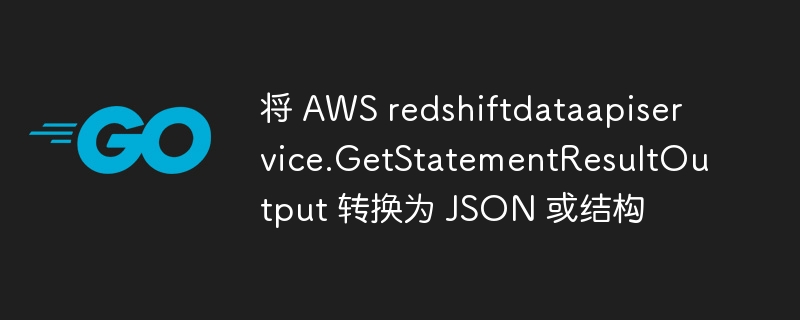Maison >développement back-end >Golang >Convertir AWS redshiftdataapiservice.GetStatementResultOutput en JSON ou en structure
Convertir AWS redshiftdataapiservice.GetStatementResultOutput en JSON ou en structure
- 王林avant
- 2024-02-06 10:54:04576parcourir

J'ai une base de données AWS Redshift Serverless que j'interroge via les SDK AWS Go redshiftdataapiservice. La requête et tout ça fonctionne, mais les enregistrements sont renvoyés dans un format difficile à utiliser/comprendre.
Mon code est comme ceci :
import (
"fmt"
"log"
"time"
"os"
"context"
"github.com/aws/aws-sdk-go-v2/aws"
"github.com/aws/aws-sdk-go-v2/config"
"github.com/aws/aws-sdk-go-v2/service/redshiftdata"
"github.com/aws/aws-sdk-go-v2/service/redshiftdata/types"
)
// Execute a Redshift query and return a result statement output
func executeRedshiftQuery(sql string) (*redshiftdata.GetStatementResultOutput, error) {
// Load the Shared AWS Configuration (~/.aws/config)
cfg, err := config.LoadDefaultConfig(context.TODO(), config.WithRegion(os.Getenv("AWS_REGION")))
if err != nil {
return nil, err
}
// Create a service client
redshiftclient := redshiftdata.NewFromConfig(cfg)
execStmt, err := redshiftclient.ExecuteStatement(context.TODO(), &redshiftdata.ExecuteStatementInput{
WorkgroupName: aws.String(os.Getenv("WG_NAME")),
Database: aws.String(os.Getenv("DB_NAME")),
Sql: aws.String(sql),
})
if err != nil {
return nil, err
}
// wait for query to finish
for {
descStmt, err := redshiftclient.DescribeStatement(context.TODO(), &redshiftdata.DescribeStatementInput{
Id: execStmt.Id,
})
if err != nil {
return nil, err
}
// return an error if the query failed or aborted
if descStmt.Status == types.StatusStringFailed || descStmt.Status == types.StatusStringAborted {
err := errors.New("the Redshift query failed or was aborted")
return nil, err
} else if descStmt.Status != types.StatusStringFinished {
time.Sleep(1 * time.Second)
continue
}
break
}
// get the results
resultStmt, err := redshiftclient.GetStatementResult(context.TODO(), &redshiftdata.GetStatementResultInput{
Id: execStmt.Id,
})
if err != nil {
return nil, err
}
return resultStmt, nil
}
Je trouve difficile de travailler avec des tableaux 2D de *Field. Comment puis-je (de préférence simplement) mapper cela à un JSON utilisable, ou plutôt à un tableau de structures de type ? Ou existe-t-il un moyen de demander JSON à Redshift ? Si possible, j'aimerais conserver tout cela entièrement dans mon application Golang.
Bonne réponse
Je n'ai pas trouvé de moyen officiel, mais la méthode ci-dessous fonctionne en créant un fragment de mappage des noms de colonnes sur les valeurs des colonnes, puis en les désorganisant à partir de là.
// Extracts the column name from column metadata for a given column index
func getColumnName(metadata []types.ColumnMetadata, index int) string {
if index < len(metadata) {
// We assume the metadata is in the same order as the columns in the record.
// If the column name is not set or empty, we can fallback to a default naming convention.
if metadata[index].Name != nil {
return *metadata[index].Name
}
return fmt.Sprintf("column_%d", index)
}
// Fallback if the index is out of range of the metadata slice.
return fmt.Sprintf("unknown_column_%d", index)
}
// Converts query results to JSON bytes for easy unmarshaling to structs
func queryResultsToJSON(query_results *redshiftdata.GetStatementResultOutput) ([]byte, error) {
// Convert the records to a slice of maps for JSON conversion
var records []map[string]interface{}
for _, row := range query_results.Records {
record := make(map[string]interface{})
for idx, col := range row {
// Use the column metadata to determine the name of the column
columnName := getColumnName(query_results.ColumnMetadata, idx)
// Check the type of the value and assign it to the record map
var value interface{}
switch v := col.(type) {
case *types.FieldMemberBlobValue:
value = v.Value
case *types.FieldMemberBooleanValue:
value = v.Value
case *types.FieldMemberDoubleValue:
value = v.Value
case *types.FieldMemberIsNull:
value = nil
case *types.FieldMemberLongValue:
value = v.Value
case *types.FieldMemberStringValue:
value = v.Value
}
record[columnName] = value
}
records = append(records, record)
}
// Marshal the records to JSON
jsonBytes, err := json.Marshal(records)
if err != nil {
log.Error("failed to marshal records to JSON, " + err.Error())
return nil, err
}
return jsonBytes, nil
}Ce qui précède est le contenu détaillé de. pour plus d'informations, suivez d'autres articles connexes sur le site Web de PHP en chinois!

